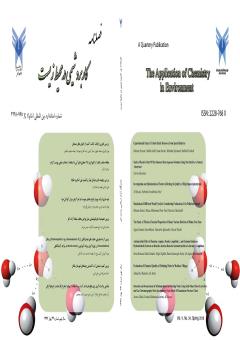کاربرد نانوتکنولوژی در انرژی تجدیدپذیر
محورهای موضوعی : نانوتکنواوژی
1 - گروه فیزیک، واحد نراق، دانشگاه آزاد اسلامی، نراق، ایران
کلید واژه: نانوتکنولوژی, انرژیهای تجدیدپذیر, مصرف انرژی, فناوری نانو, محیط زیست,
چکیده مقاله :
فناوری نانو دارای پتانسیل پیشرفتهای بنیادی فراوانی در بهبود منابع انرژی متداول (سوختهای هستهای و فسیلی) و همچنین منابع انرژی تجدیدپذیر است. پیشرفتهای شگرف فناوری نانو به واسطه معرفی فناوریهایی با بازده بالاتر، قیمت کمتر و مناسب از لحاظ زیستمحیطی به ما امکان میدهد در تأمین انرژی برای سامانههای مختلف فراتر از گزینههای فعلی قدم برداریم. انرژیهای تجدیدپذیر و نانوتکنولوژی دو حوزهای هستند که میتوانند در صنعت پالایش نفت تأثیرات مثبتی داشته باشند. انرژیهای تجدیدپذیر چون خورشیدی، بادی، آبی، زمینگرمایی و بیوانرژی میتوانند به عنوان منابع انرژی جایگزین برای تامین برق و حرارت مورد نیاز پالایشگاهها به کار روند و کمک کنند تا از وابستگی به سوختهای فسیلی کاسته شود. نانوتکنولوژی در بهبود فرآیندهای پالایش، افزایش کارایی و پایداری تجهیزات و کاتالیستها و پاکسازی محیط زیست نقش دارد. مثلاً، استفاده از نانوکاتالیستها میتواند سرعت واکنشهای شیمیایی را افزایش دهد و مصرف انرژی را کاهش دهد. نانوفیلترها نیز میتوانند در تصفیه فاضلابهای پالایشگاهی مورد استفاده قرار گیرند تا آلایندهها را با دقت بالا جدا کنند. به طور کلی، این فناوریها میتوانند به افزایش بهرهوری و کاهش آثار زیستمحیطی ناشی از فعالیتهای پالایشگاهی کمک کنند و گامی بزرگ در جهت توسعه پایدار به شمار میروند.
Nanotechnology has the potential for many fundamental improvements in the improvement of conventional energy sources (nuclear and fossil fuels) as well as renewable energy sources. Tremendous advances in nanotechnology by introducing technologies with higher efficiency, lower price and environmentally friendly allow us to go beyond current options in providing energy for various systems. Renewable energies and nanotechnology are two areas that can have positive effects in the oil refining industry. Renewable energies such as solar, wind, water, geothermal and bioenergy can be used as alternative energy sources to provide electricity and heat needed by refineries and help to reduce dependence on fossil fuels. Nanotechnology plays a role in improving refining processes, increasing the efficiency and stability of equipment and catalysts, and cleaning the environment. For example, the use of nanocatalysts can increase the speed of chemical reactions and reduce energy consumption. Nanofilters can also be used in refinery wastewater treatment to separate pollutants with high precision. In general, these technologies can help increase productivity and reduce the environmental effects of refinery activities and are considered a big step towards sustainable development.
[1] Varsada, B., 2021, Application of nanotechnology in renewable energy. A business dissertation, School of petroleum management pandit deendayal energy university gandhingar.
[2] Sahaym, U., Norton, M. G., 2008, Advances In The Application of Nanotechnology in Enabling a Hydrogen Economy. Journal of Materials Science, 43, 5395-5429.
[3] Echiegu, E. A., 2016, Nanotechnology as a Tool for Enhanced Renewable Energy Application in Developing Countries. Journal of Fundamentals of Renewable Energy and Applications, 6(6), e113.
[4] Jamiati, M., 2020, Kinetic Energy Distribution for Neutron-Induced Fission of Thorium Isotopes. Physics of Atomic Nuclei, 83, 859–865.
[5] Fagan, R., 2013, Chapter Green Nanotechnology: Development of Nanomaterials for Environmental and Energy Applications, in Shamim, Washington, DC, American Chemical Society.
[6] Schertel, L., Vignolini, S., 2020, Nanotechnology in a Shrimp Eye’s View. Nature Nanotechnology, 15, 87-88.
[7] Patil, A., Mishra, V., Thakur, S., Riyaz, B., Kaur, A., Khursheed, R., Patil, K., Sathe, B., 2019, Nanotechnology Derived Nanotools in Biomedical Perspectives: An update. Current Nanoscience, 15, 137-146.
[8] Kumaş, K., Özhan Akyüz, A., 2020, An overview on the use of nanotechnology in the renewable energy field. nternational Journal of Energy Applications, 7 (4), 143– 148.
[9] Jamiati, M., 2021, Modeling of MaximumSolar Power Tracking by Genetic Algorithm Method. Iranian (Iranica) Journal of Energy & Environment, 12(2), 118–124.
[10] Raj S., Jose S., Sumod U.S., Sabitha M., 2012, Nanotechnology in cosmetics: Opportunities and challenges. J. Pharm. Bioallied Sci., 4, 186–193.
[11] Jamiati, M., 2024, An overview of carbon nanotubes and their manufacturing method. The Application of chemistry in environment, 14(55), 59–65.
[12] Yayayürük, A., Yayayürük, O., 2019, Applications of Green Chemistry Approaches in Environmental Analysis. Current Analytical Chemistry, 15, 745 – 758.
[13] Xu, H., Liu, L., Wang, Y., Qi, D., Lu, N., 2013, Fabrication of antireflective compound eyes by imprinting. ACS Appl. Mater. Interfaces, 5, 12799–12803.
[14] Kumaş, K., Akyüz, A. Ö., 2020, An overview on the use of nanotechnology in the renewable energy field. International Journal of Energy Applications and Technologies, 7(4), 143–148.
[16] Rezaei, M., Bostani, H. A., Bani Adam, F., 2016, Investigating the applications of nanotechnology in the process of solar energy electricity production. Proceedings of the 4th specialized conference on nanotechnology in the electricity and energy industry; 2016 August, Tehran, Iran.


